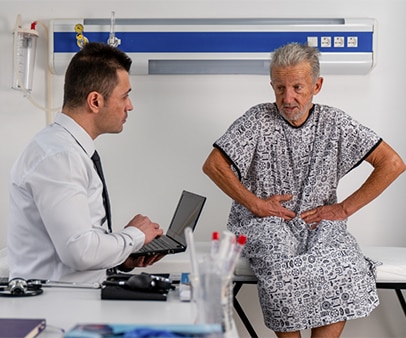A hernia is often diagnosed by clinical examination and typically appears as a small lump that looks more pronounced when you cough or do strenuous exercise, such as lifting something heavy. To diagnose a hernia, your doctor will feel for a lump and may ask you to stand from a seated position. He or she may also ask you to cough to make the hernia bulge more prominent.
However, for a more informed diagnosis, your doctor may ask you to undergo a diagnostic procedure like an ultrasound, CT scan, or MRI scan. Read on to learn more about each procedure and its associated benefits and risks.
1. Ultrasound
Accurate, non-invasive, relatively inexpensive, and readily available, an ultrasound uses sound waves to create images of the abdomen and pelvic organs.1 A handheld device called a transducer is placed on the abdomen, sending images to a computer screen to be viewed.2
If you are a woman, an ultrasound allows doctors to check for other pelvic conditions such as ovarian cysts or fibroids that can cause abdominal pain. In men, they can help diagnose scrotal or inguinal hernias.2
What to Expect During an Ultrasound3
On average, an abdominal ultrasound takes around 30 minutes to complete. Depending on your specific situation, it may take more or less time. An ultrasound may be performed in your doctor’s office. Or, you may be instructed to go to an imaging center. During an abdominal ultrasound, a healthcare provider will usually:
- Apply gel to your abdomen
- Move the probe/ultrasound wand over your skin on top of the gel
- Provide instructions (e.g., hold your breath, turn to one side, etc.)
- Wipe off any remaining gel
After your test, a radiologist will review your ultrasound pictures, write a report of their findings, and send it to your healthcare provider. In most cases, results are available in about a week or less.
Benefits of an Ultrasound4
An ultrasound image can provide valuable insights into the size, location and characteristics of a hernia. This in turn can help your doctor create an individualized treatment plan specific to your hernia needs. Due to its non-invasive detection techniques, an ultrasound is a preferred choice for pregnant women and those who may need repeated imaging.
Risks of an Ultrasound5
There are no known risks associated with ultrasounds. Unlike other imaging techniques that require exposure to radiation, an ultrasound relies on sound waves to identify the hernia. Due to its non-invasive detection techniques, an ultrasound is a preferred choice for pregnant women and those who may need repeated imaging.
However, since sound waves don’t travel well through air or bone, ultrasounds are less-effective in imaging body parts that are hidden by bone, have gas, or are located deep in the body.
2. CT Scan
A Computed Tomography (CT) scan is a procedure that utilizes X-ray images and computer technology to create detailed images of the abdomen and its organs. To help make the organs more visible on the images, you may be given a contrast dye orally or intravenously (through a vein in your arm) before the test.
What to Expect During a CT Scan6
A CT scan usually takes about an hour in total, and you’ll either need to go to a hospital or an imaging center. Though most of that time is for the preparation—the scan itself often takes less than 15 minutes. To start, you’ll lie on your back on a table/bed and then:
- The table/bed will move into a doughnut-shaped scanner
- You may be asked to hold your breath
- The scanner will take pictures
- When finished, the table/bed will move back out of the scanner
It typically takes 24 to 48 hours to get the results of a CT scan. A radiologist will review your scan(s), write a report of their findings, and send it to your doctor. Once both the radiologist and your doctor review the results, your healthcare provider may have you schedule another appointment to go over the findings.
Benefits of CT Scans4
CT scans can effectively detect complex hernias and evaluate potential complications such as hernia obstruction or strangulation. They are able to provide detailed anatomical information, aiding in treatment planning. While ultrasound provides real-time images, CT scans offer a more comprehensive evaluation of the hernia, its size, location, and potential complications.
Risks of CT Scans4
Because CT scans use x-rays to create detailed, cross-sectional images of the body, the main risk is the exposure to radiation. Additionally, some individuals may have an allergic reaction to the contrast dye that may be used during the CT scan. Allergic reactions to the contrast dye can range from mild to severe, including symptoms like rash, itching, difficulty breathing, swelling, nausea/vomiting, headaches or dizziness.6
2. MRI
Magnetic Resonance Imaging (MRI) uses radio waves and a magnetic field to generate images of the abdomen and its organs. To help make the organs more visible on the images, you may be given a contrast dye orally or intravenously (through a vein in your arm) before the test. In the event a hernia is present without a bulge, an MRI can reveal if/where there is a tear in the abdomen.2
What to Expect During an MRI7
There are two types of MRIs–a Closed MRI and an Open MRI. Depending on the type of exam and equipment used, an MRI usually lasts between 30-50 minutes and can be noisy. During that time, you must remain completely still because movement can affect the quality of the MRI images.
Closed MRI
When you go in for a Closed MRI, you’ll change into a hospital gown and lie on your back on a scanning bed. You may be given earplugs or headphones. Once the exam begins, your scanning bed will move into the machine and you will usually:
- Hear loud knocking/clicking sounds as the equipment takes the images
- Be asked to remain completely still
- Feel a slight warmth in the area of the scan (this is normal)
- Have access to a call button in the event you’re having problems or concerns
When finished, the table/bed will move back out of the scanner. A radiologist will review your scan(s), write a report of their findings, and send it to your doctor. Your doctor may have you schedule another appointment to go over the results.
Open MRI
The process is generally the same for Open and Closed MRIs. However, with an Open MRI, rather than being in an enclosed capsule, these machines use a magnetic bottom and top and all four sides are open. It’s possible to also have the scan done standing up versus laying down. This not only helps accommodate overweight or physically disabled patients who can’t use a closed machine appropriately, it may also help reduce the risk of panic attacks and claustrophobia.7
Due to the shape of the Open MRI, it is unable to take images of certain areas of the body and the images may be of lesser quality in comparison to Closed MRI machines.7
Benefits of MRI Scans4
MRIs provide detail and clarity, making them particularly useful for complex hernias or cases where surgical planning requires precise anatomical information.
Risks of MRI Scans4
MRIs are generally safe and do not involve exposure to radiation. However, individuals with certain metallic implants or devices may not be suitable candidates for an MRI due to the strong magnetic fields. In addition, individuals with claustrophobia may not feel comfortable in a Closed MRI. Allergic reactions to the contrast dye can range from mild to severe, including symptoms like rash, itching, difficulty breathing, swelling, nausea/vomiting, headaches or dizziness.6
The guidance provided in this article follows general rules that should be discussed with your doctor. This article is for informational and educational purposes only. It does not substitute for medical advice. If in doubt, always consult your doctor.
Related Articles
Join the HerniaInfo.com community! Get notified about our latest articles and updates on all things hernia as they become available.


